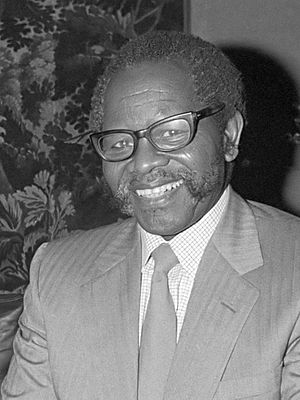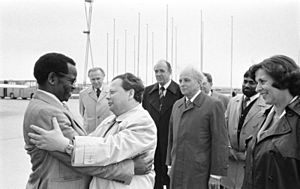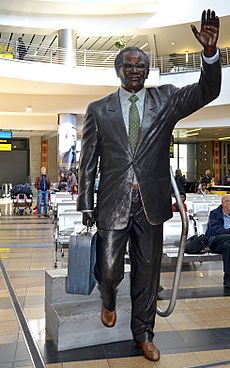Oliver Tambo facts for kids
Quick facts for kids
Oliver Tambo
|
|
|---|---|

Tambo in 1981
|
|
| Born |
Oliver Reginald Kaizana Tambo
27 October 1917 Nkantolo, Bizana, Union of South Africa
|
| Died | 24 April 1993 (aged 75) Johannesburg, Transvaal, Republic of South Africa
|
| Other names | "O.R." |
| Occupation | Teacher and lawyer |
| Known for | President of the African National Congress |
| Spouse(s) | |
| Children | Dali Tambo (son), Tselane Tambo (daughter), Thembi Tambo (daughter), Oliver Jnr, Ayabulela Tambo (granddaughter) |
Oliver Reginald Kaizana Tambo (October 27, 1917 – April 24, 1993) was an important South African leader. He fought against apartheid, which was a system of unfair racial separation in South Africa. He was the President of the African National Congress (ANC) from 1967 to 1991. The ANC was a group that worked to end apartheid and create a fair society for everyone in South Africa.
Contents
Oliver Tambo's Early Life
Growing Up and School
Oliver Tambo was born on October 27, 1917, in a small village called Nkantolo in what is now the Eastern Cape of South Africa. His village was mostly made up of farmers. Oliver's father, Mzimeni Tambo, was a farmer's son and also worked as a salesperson. Oliver's mother was named Julia.
Oliver was a very bright student. In 1938, he finished high school as one of the best students. He then went to the University of Fort Hare. However, in 1940, he and other students, including Nelson Mandela, were asked to leave the university. This happened because they took part in a student protest. In 1942, Tambo went back to his old high school in Johannesburg. There, he taught science and mathematics.
Fighting for Change
Starting the Youth League
In 1944, Oliver Tambo, Nelson Mandela, and Walter Sisulu started the African National Congress Youth League. Tambo became its first National Secretary. This Youth League wanted to change how the fight against apartheid was being done. Before, the ANC mostly used petitions and peaceful demonstrations. The Youth League believed stronger actions were needed.
They created a "Programme of Action." This plan suggested using tactics like boycotts (refusing to buy or use something), civil disobedience (peacefully refusing to obey unfair laws), and strikes (refusing to work). These actions were meant to put more pressure on the government to end apartheid.
In 1955, Tambo became the Secretary-General of the ANC. This happened after Walter Sisulu was banned by the South African government. In 1958, Tambo became the Deputy President of the ANC. The government then gave him a banning order in 1959, which meant he was restricted from certain activities for five years.
Life in Exile
Because of the government's actions, the ANC decided to send Tambo out of South Africa. His mission was to gather support around the world to fight apartheid. He left on March 21, 1960. Oliver Tambo and his family settled in Muswell Hill, north London. He lived there until 1990. Being away from his wife and three children was hard. But his wife, Adelaide, continued to support the ANC back home. She even welcomed ANC members who arrived from the UK.
In 1967, Tambo became the Acting President of the ANC after Chief Albert Lutuli passed away. He worked hard to keep the ANC united, even while he was in exile. His great leadership helped him attract many talented South Africans who were also in exile, like Thabo Mbeki.
The Struggle Continues
During the fight against apartheid, the ANC, under Tambo's leadership, sometimes used more direct actions against the government. These actions were part of a difficult struggle to end the unfair system of apartheid. The ANC aimed to target government and military sites. However, sometimes these actions led to unintended harm to civilians.
After apartheid ended, the Truth and Reconciliation Commission (TRC) looked into many events from this time. The TRC found that Oliver Tambo had approved some of these actions. For example, a bombing in 1983 was carried out by the ANC's military wing, Umkhonto we Sizwe (MK). The ANC explained that this bombing was a response to attacks by the South African government on ANC supporters. The TRC heard all sides and granted amnesty to those involved, which means they were forgiven for their actions as part of the reconciliation process.
In 1985, Oliver Tambo was re-elected as President of the ANC.
Return Home
Oliver Tambo returned to South Africa on December 13, 1990. He had been in exile for over 30 years. He could finally come back because the ANC was made legal again. When he returned, many people welcomed him, even some who had been his rivals.
However, he had suffered a stroke in 1989, which made it difficult for him to fully carry out his duties as President of the ANC. So, in 1991, Nelson Mandela took over as president. Even though he stepped down, the ANC created a special position for him as the National Chairman.
His Final Years
Oliver Tambo passed away on April 24, 1993, at the age of 75, after complications from his stroke. His death happened just before the 1994 general election, where Nelson Mandela became the first President of a democratic South Africa. Mandela, Thabo Mbeki, and Walter Sisulu attended his funeral. Tambo was buried in Benoni, Gauteng.
International Connections
Oliver Tambo's strong fight against apartheid led him to build many important relationships around the world. In 1977, Tambo signed an agreement between the ANC and the Italian town of Reggio Emilia. This was the first time a city in the world signed such a pact of support with the ANC. This began a long friendship that led Italy to help the people of southern Africa. One way they helped was by organizing "solidarity ships." The first ship, named "Amanda," left from Genova in 1980. Tambo himself asked Reggio Emilia to make Isitwalandwe Medals, which are the highest honours given by the ANC.
Legacy and Honours
Oliver Tambo has been honoured in many ways. In 2004, he was voted number 31 in a TV show called Great South Africans.
In 2005, there were plans to rename Johannesburg International Airport after him. This idea was discussed a lot. Even though some people had different ideas, the proposal was accepted. The airport was officially renamed O. R. Tambo International Airport on October 27, 2006.
There is also a sculpture of Tambo in the Albert Road Recreation Ground in Muswell Hill, London, near where he used to live. In 2021, this park was renamed the O.R. Tambo Recreation Ground. In June 2013, the city of Reggio Emilia in Italy also created a park named after him.
His house in London was bought by the South African Government in 2010. It is now a historic monument and has a special plaque.
Tambo's grave was declared a National Heritage site when he died. It lost this status for a short time when his wife, Adelaide Tambo, was buried next to him. However, their grave was re-declared a National Heritage site in October 2012.
In 2017, a special event was held to celebrate 100 years since Tambo's birth. This event also remembered the sinking of the troopship SS Mendi.
See also
 In Spanish: Oliver Tambo para niños
In Spanish: Oliver Tambo para niños
- List of people subject to banning orders under apartheid



